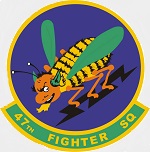Hobby Master HA1325 USAF Fairchild Republic A-10C Thunderbolt II Ground Attack Aircraft - "Hairless Joe", 47th Tactical Fighter Squadron "Termites", 917th Fighter Group, Barksdale AFB, 2012 [Low-Vis Scheme] (1:72 Scale)
"Obsolete weapons do not deter."
- British Prime Minister Margaret Thatcher
 The A-10 and OA-10 Thunderbolt IIs are the first Air Force aircraft designed specifically for close air support of ground forces. They are simple, effective, and highly survivable twin-engine jet aircraft that can be used against all ground targets, especially tanks and other armored vehicles. The first production A-10A was delivered to Davis-Monthan Air Force Base, AZ., in October 1975.
The A-10 and OA-10 Thunderbolt IIs are the first Air Force aircraft designed specifically for close air support of ground forces. They are simple, effective, and highly survivable twin-engine jet aircraft that can be used against all ground targets, especially tanks and other armored vehicles. The first production A-10A was delivered to Davis-Monthan Air Force Base, AZ., in October 1975.
The aircraft can carry a wide variety of ordnance under its wings and nose, loiter on-station for long periods of time, and fly over a wide combat radius, making it an ideal warrior on today's battlefield. In the Gulf War, A-10s, with a mission capable rate of 95.7 percent, flew 8,100 sorties and launched 90 percent of the AGM-65 Maverick missiles used in-country.
In 2005, the entire fleet of 356 A-10 and OA-10 aircraft began receiving the Precision Engagement upgrades including an improved fire control system (FCS), electronic countermeasures (ECM), and smart bomb targeting. The aircraft receiving this upgrade were redesignated A-10C. The Government Accounting Office in 2007 estimated the cost of upgrading, refurbishing, and service life extension plans for the A-10 force to total $2.25 billion through 2013. In July 2010, the USAF issued Raytheon a contract to integrate a Helmet Mounted Integrated Targeting (HMIT) system into the A-10C. The Air Force Material Command's Ogden Air Logistics Center at Hill AFB, Utah completed work on its 100th A-10 precision engagement upgrade in January 2008. The final aircraft was upgraded to A-10C configuration in June 2011. The aircraft also received all-weather combat capability, and a Hand-on-Throttle-and-Stick configuration mixing the F-16's flight stick with the F-15's throttle. Other changes included two multifunction displays, a modern communications suite including a Link-16 radio and SATCOM. The LASTE system was replaced with the integrated flight and fire control computer (IFFCC) included in the PE upgrade.
Throughout its life, the platform's software has been upgraded several times, and although these upgrades were due to be stopped as part of plans to retire the A-10 in February 2014, Secretary of the Air Force Deborah Lee James ordered that the latest upgrade, designated Suite 8, continue in response to Congressional pressure. Suite 8 software includes IFF Mode 5, which modernizes the ability to identify the A-10 to friendly units. Additionally, the Pave Penny pods and pylons are being removed as their receive-only capability has been replaced by the AN/AAQ-28(V)4 LITENING AT targeting pods or Sniper XR targeting pod, which both have laser designators and laser rangefinders.
In 2012, Air Combat Command requested the testing of a 600-US-gallon (2,300 l; 500 imp gal) external fuel tank which would extend the A-10's loitering time by 45-60 minutes; flight testing of such a tank had been conducted in 1997 but did not involve combat evaluation. Over 30 flight tests were conducted by the 40th Flight Test Squadron to gather data on the aircraft's handling characteristics and performance across different load configurations. It was reported that the tank slightly reduced stability in the yaw axis, but there was no decrease in aircraft tracking performance.
This particular 1:72 scale replica of a USAF A-10C Thunderbolt II ground attack aircraft nicknamed "Hairless Joe", that was attached to the 47th Tactical Fighter Squadron, 917th Fighter Group, then deployed to Barksdale AFB during 2012.
Sold Out!
Dimensions:
Wingspan: 8-3/4-inches
Length: 9-3/4-inches
Release Date: February 2018
 Historical Account: "Busy as a Bee" - The 47th Tactical Fighter Squadron is an Air Force Reserve Command unit based at Davis-Monthan Air Force Base, Arizona, and falls under the operational control of the 924th Fighter Group.
Historical Account: "Busy as a Bee" - The 47th Tactical Fighter Squadron is an Air Force Reserve Command unit based at Davis-Monthan Air Force Base, Arizona, and falls under the operational control of the 924th Fighter Group.
In June 2003, the 47th Tactical Fighter Squadron deployed to Combat Readiness Training Center, Gulfport, Mississippi for Operation Patriot Pursuit.
In April 2004, the 47th Tactical Fighter Squadron hosted Hawgsmoke 2004 at the England Air Park, Louisiana. There were 18 A-10 teams from all over the world deployed to participate in the biennial A-10 bombing and tactical gunnery competition. The 47th Tactical Fighter Squadron deployed to MacDill Air Force Base, Florida for Operation Patriot Gator the end of July through the first of August 2004.
In 2005, the 47th Tactical Fighter Squadron deployed to McChord Air Force Base, Washington, for Operation Patriot Lightning, a close air support training exercise in conjunction with the Army National Guard.
In 2006, under Base Realignment and Closure the 47 FS gained eight A-10 aircraft and a number of full-time and part-time positions. In March the 47th Fighter Squadron won third overall out of 17 teams in Hawgsmoke 2006 at Davis-Monthan Air Force Base, Arizona. Also in March, they participated in Operation Atlantic Strike III, a joint training exercise held at MacDill Air Force Base, Florida.
The school graduated about 45 active-duty, Air National Guard and Air Force Reserve students per year.
On October 1st, 2011, the 47th Tactical Fighter Squadron converted from a training unit to a combat coded unit. January 2012, the 917 Wing split. The wing's B-52 squadron, the 93 BS, folded under a new 307 BW and the 47th Tactical Fighter Squadron organized under the new 917th Fighter Group. The 917 Fighter Group was reassigned to the 442d Fighter Wing at Whiteman Air Force Base, MO.


